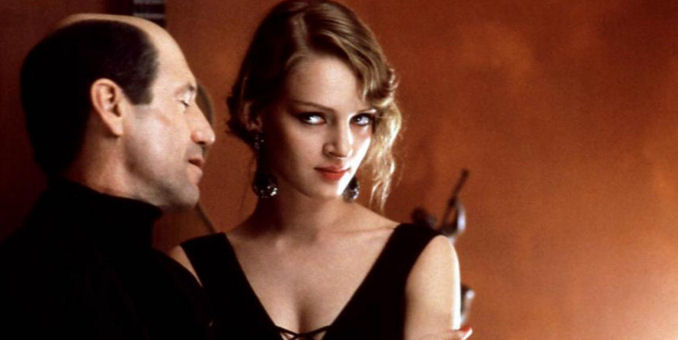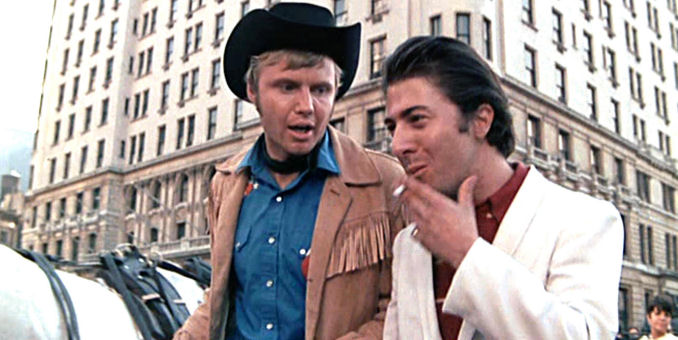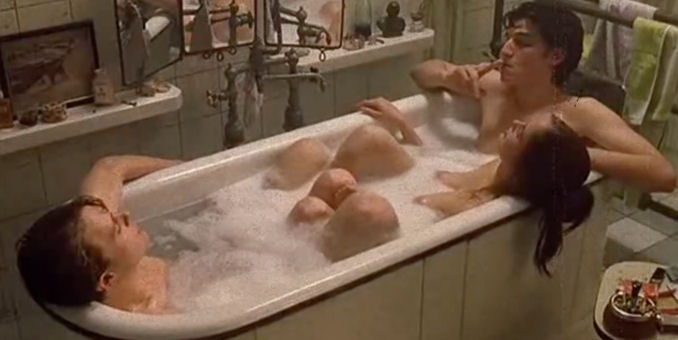On October 5, 1990, director Philip Kaufman’s film Henry & June, which dramatized the real life relationship writer Anaïs Nin had with novelist Henry Miller and his wife June, made history for becoming the first film to be released with the newly created NC-17 rating.
The Motion Picture Association of America minted the new rating in a combined response to a number of filmmakers who were pressing hard against the boundaries of what an R-rating would allow and the need to reclaim the X-rating from the realm of pornography. Much of the background to what led to the creation of the NC-17 rating can be found in the deficiencies in the original ratings systems and changing social attitudes towards portrayals of sex and violence in media through the 1970s and 1980s. It was a potent brew that would create what would ultimately be an impotent solution.
RATED X
The roots of the NC-17 rating can be traced back to the found of the ratings system itself. In 1968, the Motion Picture Production Code, which had been in place for four decades governing what could and more importantly, could not, be placed into a movie produced in the United States, was finally done away with. In its place, Motion Picture Association of America president Jack Valenti created a new system that would create categories for films that would alert potential ticket buyers as to what kind of content may be found in each movie and whether that was appropriate for certain audiences. The first four ratings for films were – G for General Audiences, M for Mature audiences, some parental guidance suggested, R for Restricted with no one under 16 being admitted without a parent and X for no one under 16 admitted at all.
And it seemed to work fairly well at first. The M rating soon mutated into the PG rating. The X rating allowed for films to explore more mature themes as well as deal with extreme levels of violence or non-pornographic nudity. Midnight Cowboy, one of the first films to be given an X-rating by the MPAA, would become such a critical and commercial hit, it would win the Academy Awards for Best Adapted Screenplay, Best Director and Best Picture. Several other films with an X-rating would go on to be hits as well including Medium Cool, Beyond The Valley Of The Dolls, The Street Fighter, A Clockwork Orange, Sweet Sweetback’s Baadasssss Song, Fritz The Cat, Last Tango In Paris and The Evil Dead.
But the MPAA made one fatal mistake when it instituted their new ratings system – They forgot to trademark the X rating. As the porno chic craze started to sweep the nation in the early 1970s thanks to the commercial breakout of films such as Deep Throat, The Devil In Miss Jones and Behind The Green Door, pornography producers bypassed actually submitting their films to the MPAA for the expected X rating. Instead, they began to commandeer the rating, self-applying it to their output. In a bid to out sensationalize each other, they created the Double-X and Triple-X rating. The National Organization of Theater Owners even tried to alert Valenti and the MPAA about the erosion of the X-rating but their warnings went unheeded.
Although the porno chic period would basically come to an end by the mid-1980s thanks to the rise of the home video cassette player eliminating the need for people to leave their homes to get their porn fix, it had already done its damage to the intention of the X-rating. No film studio would want to produce a challenging, adult-themed film that would get an X-rating, as the X was now irrevocably linked with porn. There is an irony in the fact that the loosening of restrictions on what could be depicted on screen via the establishment of the new ratings system ultimately led to film producers hijacking that system and defeating its original purpose, but Hollywood wasn’t amused.
THIS FILM IS NOT RATED
As X-rated films faded from local theaters and onto video cassettes shelved in a video store’s back room partitioned off by a flimsy curtain, some filmmakers soon began pushing out on to the boundaries of what could be shown on screen as the original X-rating intended. Alan Parker was forced to trim ten seconds out of a sex scene in his 1987 neo-noir Angel Heart in order to get the film’s initial X-rating changed to an R. But those edits only came after he fought against both the MPAA and his own studio to avoid having to make them. Two years later, Harvey Weinstein deliberately encouraged producers Steve Woolley and Nik Powell to deliver to his company Miramax an X-rated cut of their film Scandal, clearly with the intention of using the publicity surrounding it getting that rating and them him very loudly appealing it as a way to hopefully draw in ticket buyers.
But 1990 is when things truly took a turn.
John McNaughton’s Henry: Portrait of a Serial Killer had premiered at the Chicago International Film Festival in the fall of 1986, but remained unseen outside of a few film festivals, unable to find a distributor because of the film’s violence. McNaughton had been told that there were no specific cuts he would be able to make to the film to receive an R rating as the whole film’s overall tone is what earned it an X-rating.
Critics Gene Siskel and Roger Ebert would champion the film’s cause on an April 1990 episode of their syndicated film review show Siskel & Ebert as the film started to play at a handful of festivals, including the Telluride Film Festival the previous fall, to much audience and critical debate over its uncompromising character study of a real-life murderer. The pair took the moment to advance the idea that there should be a rating for material too strong for an R – A for Adult.
“It’s an irony that mad slasher films like the Friday The 13th series routinely get an R rating from the MPAA and play at millions of teenagers, anyone who can find that mythical 18 year old adult guardian to go in with them, but let an artistic film come along that really sincerely considers the subject and it’s banished by the MPAA to that ghetto between the R and the X, so that most theater chains are afraid or legally prevented from booking it,” Ebert complained. “This film deserves to be seen. This must be the only civilized country on Earth to believe that doesn’t believe there is such a thing as an adults only movie.”
On that same episode, the pair also reviewed Peter Greenaway’s The Cook, The Thief, His Wife & Her Lover, which Greenaway had released unrated rather than make cuts to it to earn an R rating. While noting the film as an allegory for then Thatcher-ite Great Britain, Ebert railed against the MPAA stating “[the movie] is a very powerful social film, and of course, needless to say, the MPAA couldn’t give it an R rating because if there is anything they can’t stand, it’s a movie that goes outside their little blinders.”
Siskel concurred, stating “I am glad that [Greenaway and distributor Miramax] didn’t make cuts. We can handle this material.”
Siskel and Ebert were able to see past the alleged prudishness of the MPAA ratings board to address the real culprit at work – money. An R rating may attempt to restrict what audience a movie gets, but it is fairly ineffectual for teenagers to circumvent and still get money into box office cash registers. A strictly adults only film would require theaters to be more diligent about whom they sold tickets to as well as being alert for teens buying admission to a lower rated film and then sneaking into an A-rated one. Additionally, many newspapers and television and radio outlets had policies that prohibited them from advertising unrated and X-rated films, significantly hurting a film’s chance to find an audience. And that is even if the film could find a theater that would be able to book the film.
The idea that an unrated film had the economic cards stacked against it was at the heart of a lawsuit that Miramax filed against the MPAA less than two months after Siskel & Ebert’s plea for an A-rating. The suit argued that the MPAA’s X-rating for Pedro Almodóvar’s Tie Me Up! Tie Me Down! held the film back from earning more than the $4 million it managed to pull at the US box office after the distributor chose to release the film unrated.
The judge in the case found in favor of the MPAA, but did note that the Motion Picture Association of America needed more transparency in the ratings process and that the organization’s “rating system censors serious films by the force of economic pressure.” (This is an observation that forms the thesis of Kirby Dick’s 2006 documentary This Film Is Not Rated, which goes on to posit that since the MPAA is funded only by the major studios, it protects the interests of those studios by giving more lenient ratings to their output than they would to films with similar content coming from smaller, indie studios and distributors.)
MPAA chief Valenti was reluctant to make any changes, however. But as the summer of 1990 wore on, the pressure mounted. More critics joined Siskel and Ebert’s call for a rating that would allow films with strong adult content to stand out from just straight pornography. As the season drew to a close, both Frank Henenlotter’s horror comedy Frankenhooker and Hong Kong director Wayne Wang’s film Life Is Cheap… But Toilet Paper Is Expensive were released by their directors with self-imposed A for”Adult” ratings, rejecting the X that their movies got from the MPAA.
Finally, Valenti relented. On September 26, the MPAA announced it was doing away with the X rating (and its porno stigma) and replacing it with a new rating – NC-17. Valenti stated that he hoped the new rating would return things to the original intent of the system he created twenty-some years earlier, “the days, hopefully, of Midnight Cowboy, Last Tango In Paris and A Clockwork Orange.”
A few weeks later, Kaufman’s Henry & June hit theaters, the first film with the freshly minted rating.
RATED NC-17
But for all the sturm und drang and arguing for a change in the ratings, the long-term pay off for the creation of the NC-17 was virtually nonexistent. Henry & June made a respectable, if modest, $11.5 million at the box office. Most films were not that lucky. Just a few months later, Ken Russell’s dark examination of prostitution, Whore, only earned a little over $1 million at US art houses. And this is where the cracks in the new rating began to show.
While the new rating was supposed to delineate between more adult fare and straight up porn, films with the NC-17 still had to fight many of the restrictions that X-rated films did. Newspapers and television stations would often still not carry any advertising or critical coverage of the films. Mall cinema chains still wouldn’t book them, most likely due to their lease agreements with their landlords with prohibitions against any film rated harder than an R. Blockbuster still wouldn’t carry NC-17 films on their shelves.
It fell to independently-owned art house theaters and mom-and-pop video stores to become the sole outlets for the films to be available to the public. But with not every city having a robustly programmed art cinema, and Blockbuster spending a good portion of the decade destroying all of their locally-owned competition before receiving their well deserved comeuppance from Netflix in the next decade, NC-17 rated films faced economic ghettoization.
The only solution was to either capitulate to an edited/watered down release version that earn an R-rating from the MPAA or prepare two versions for release. So many films across the 1990s – Menace II Society, True Romance, The Crow, Pulp Fiction, Desperado, Bound, Gummo, Orgazmo and The General’s Daughter to name a few across a number of genres – chose to at least trim material for a more commercially viable R, though often releasing the director’s original, unadulterated vision later.
By the end of the decade, it became apparent that the NC-17 rating was failing in what it had been intended to do. Most films given an NC-17 by the MPAA were choosing to re-edit for an R rather than go out into the marketplace with the economic cards stacked against them. But the MPAA persisted with the NC-17, and many films continued to be trimmed rather that be burdened with the rating. Some directors though – such as Bertolucci (The Dreamers), Almodovar (Bad Education) and Waters (A Dirty Shame) – kept and released their films with the NC-17s they were handed. (Alternate cuts were also prepared and ultimately released in those three examples though.)
While an NC-17 film would still turn a profit on occasion, like Blue Is The Warmest Color‘s worldwide gross of $19 million versus its $4.3 million budget, they ultimately remained either loosing or low-yielding propositions. The last NC-17 film to be released was the 2014 Canadian comedy Swearnet: The Movie, which holds the Guinness Book of World Records record for using the word “fuck” the most times in a movie – 935 times. It also holds a critics’ score of just 18 on Rotten Tomatoes. And low critics scores and box office will do more to make studios leery about producing a film that could potentially earn an NC-17 rating then anything else.








